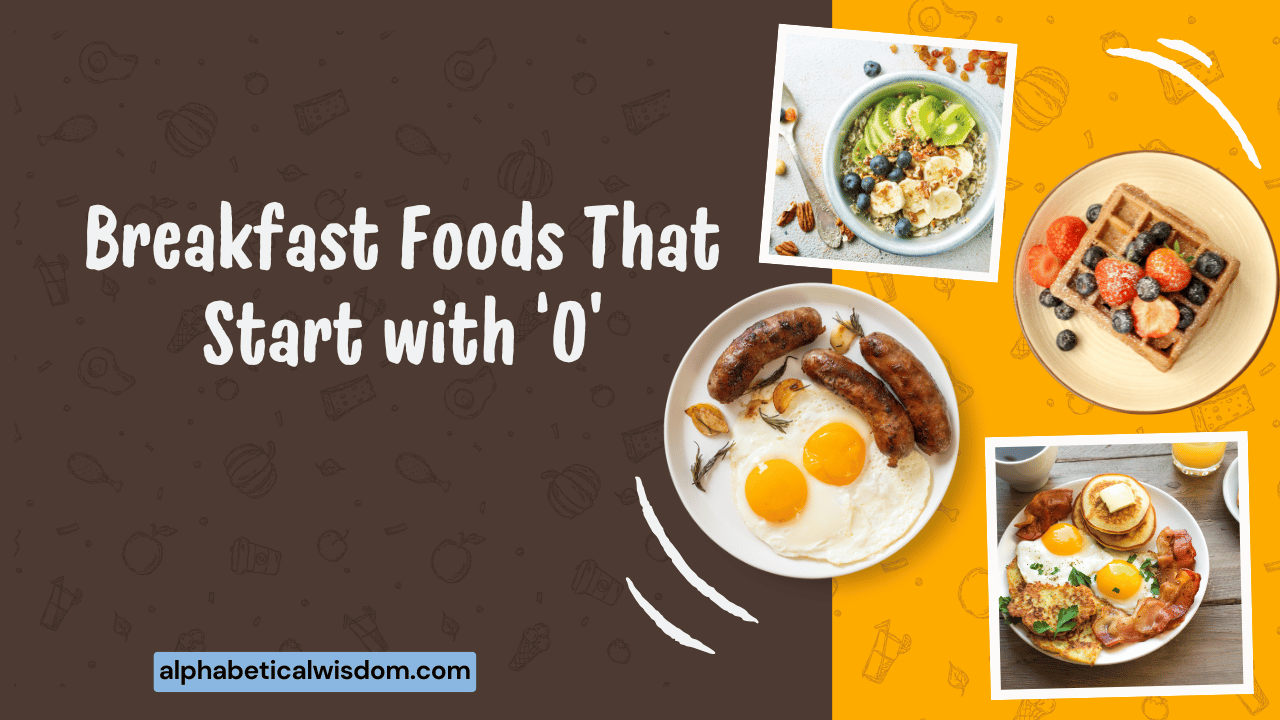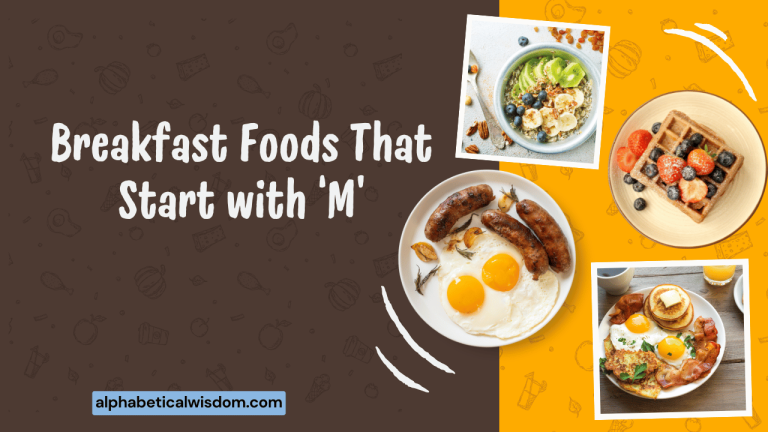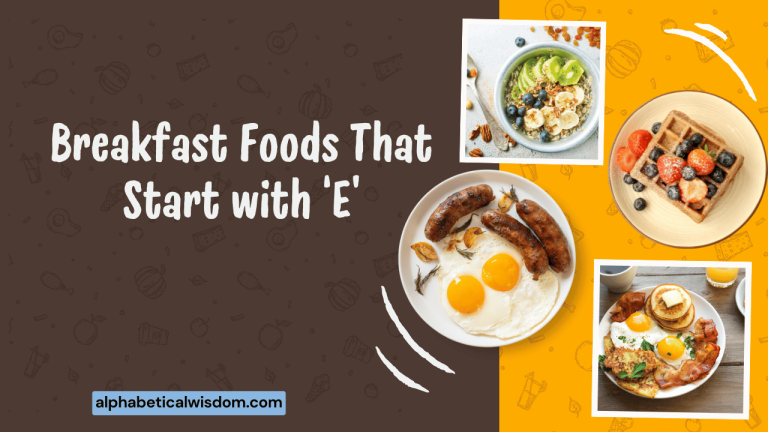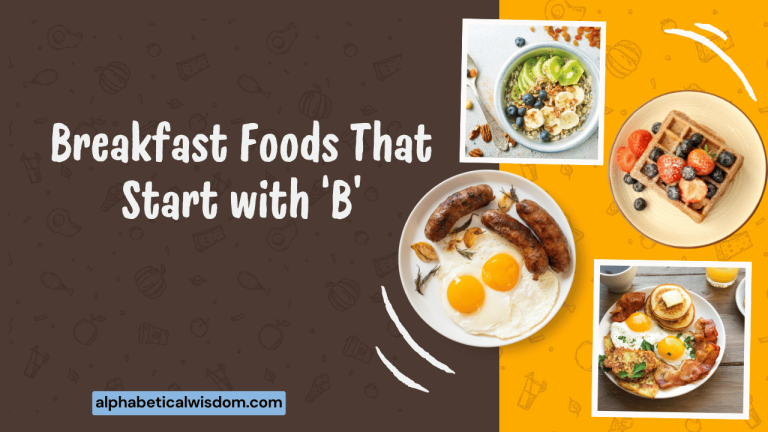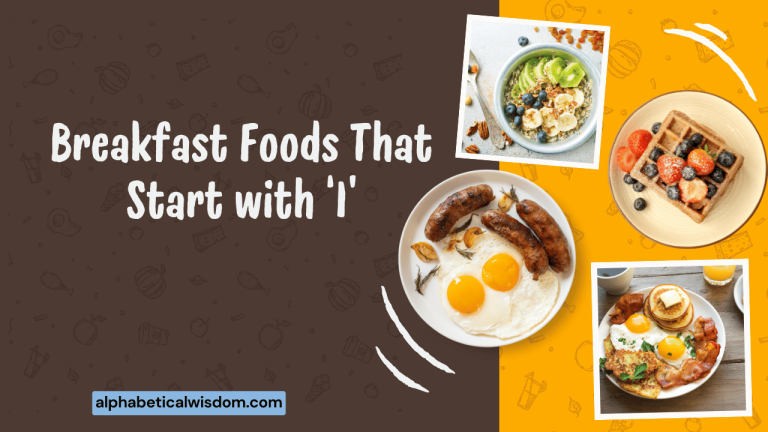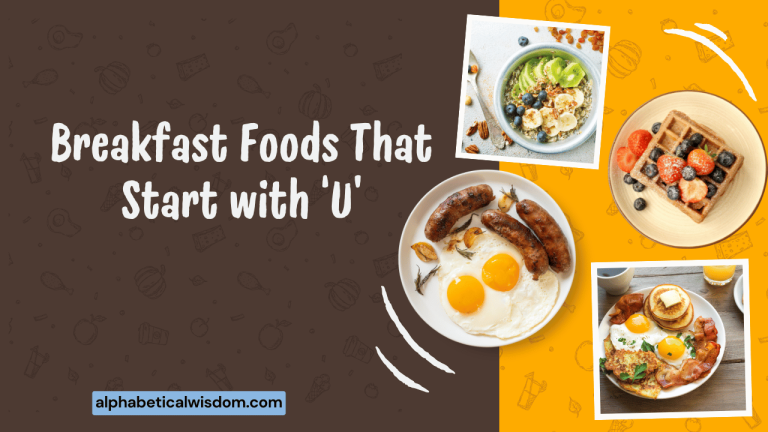Breakfast Foods That Start With O: A Grammatical Guide
Breakfast, the most important meal of the day, is filled with a variety of delicious options. But have you ever considered how these breakfast foods fit into the larger structure of English grammar?
This article explores breakfast foods starting with the letter “O” and uses them as a fun and engaging way to illustrate various grammatical concepts. Whether you are an English language learner or a grammar enthusiast, this guide will enhance your understanding of nouns, articles, quantifiers, and sentence construction, all while whetting your appetite!
Table of Contents
- Introduction
- Definition of Breakfast Foods Starting With “O”
- Structural Breakdown: Nouns and Articles
- Types and Categories of “O” Breakfast Foods
- Examples in Sentences
- Usage Rules: Articles, Quantifiers, and More
- Common Mistakes
- Practice Exercises
- Advanced Topics
- FAQ Section
- Conclusion
Definition of Breakfast Foods Starting With “O”
This section defines breakfast foods beginning with the letter “O,” focusing on their grammatical classification and function in sentences. We’ll consider how these foods are used as nouns, and how they interact with articles, quantifiers, and other grammatical elements.
Breakfast foods starting with “O” primarily function as nouns. Nouns are words that represent people, places, things, or ideas. In this context, they represent edible items commonly consumed during breakfast. These nouns can be either countable (items that can be individually counted) or uncountable (items that cannot be individually counted without a unit of measurement). For example, an omelet is countable (one omelet, two omelets), while oatmeal is generally uncountable (some oatmeal, much oatmeal).
The grammatical function of these nouns extends to various roles within a sentence, such as the subject (the one performing the action), the object (the one receiving the action), or the complement (providing additional information about the subject or object). For instance, in the sentence “I eat oatmeal,” “oatmeal” is the object of the verb “eat.”
Structural Breakdown: Nouns and Articles
Understanding the structure of sentences involving breakfast foods that start with “O” requires a grasp of how nouns and articles interact. Articles are words (“a,” “an,” “the”) that define whether a noun is specific or unspecific.
They are crucial for clarity and grammatical correctness.
Countable nouns can be either singular or plural. Singular countable nouns require an article (“a,” “an,” or “the”) unless they are generic or modified by another determiner (e.g., “my omelet”). The choice between “a” and “an” depends on the sound of the following word. Use “an” before a vowel sound and “a” before a consonant sound. Plural countable nouns do not usually require an article unless referring to specific items (e.g., “The omelets were delicious”).
Uncountable nouns generally do not take “a” or “an.” Instead, they are often used with quantifiers like “some,” “much,” “a lot of,” or “the” when referring to a specific instance. For example, “I want some oatmeal” is correct, while “I want an oatmeal” is incorrect. The use of “the” with uncountable nouns indicates a specific instance or quantity, such as “The oatmeal I had this morning was perfect.”
Types and Categories of “O” Breakfast Foods
Let’s explore specific breakfast foods that start with the letter “O,” categorizing them based on their grammatical properties and common usage. This will provide a practical context for understanding the grammatical concepts discussed earlier.
Oatmeal
Oatmeal is a breakfast dish made from oats. It is typically served hot and can be flavored with various toppings like fruit, nuts, or sweeteners. Grammatically, oatmeal is generally considered an uncountable noun. This means that you cannot say “an oatmeal” unless you are referring to a specific serving or type of oatmeal (e.g., “a packet of oatmeal”).
Because it’s uncountable, you’ll often see oatmeal used with quantifiers like “some,” “a lot of,” or “much.” For instance, “I would like some oatmeal, please” is a common and grammatically correct sentence.
Omelets
An omelet (or omelette) is a dish made from beaten eggs cooked in a pan. It can be filled with various ingredients such as cheese, vegetables, or meat. Unlike oatmeal, omelets are countable nouns. You can have one omelet, two omelets, or many omelets.
As a countable noun, “omelet” requires an article when singular and non-specific. You would say “I want an omelet” because “omelet” starts with a vowel sound.
If you are referring to a specific omelet, you would use “the,” as in “The omelet I ordered was delicious.”
Orange Juice
Orange juice is a popular breakfast beverage made from oranges. Like oatmeal, orange juice is generally considered an uncountable noun. You wouldn’t say “an orange juice” unless you’re referring to a serving or container of orange juice (e.g., “a glass of orange juice”).
Similar to oatmeal, orange juice is often used with quantifiers. For example, “I drink some orange juice every morning” is a typical usage.
When referring to a specific instance, you can use “the,” such as “The orange juice tasted particularly fresh today.”
Other “O” Foods
While oatmeal, omelets, and orange juice are the most common breakfast foods starting with “O,” there might be other less frequent options depending on regional cuisines or personal preferences. Some examples include:
- Olives: Although not traditionally a breakfast food, olives can be included in a Mediterranean-style breakfast. Olives are countable nouns.
- Onions: Some breakfast dishes might include onions, such as in a breakfast hash or frittata. Onions are countable nouns.
Examples in Sentences
This section provides extensive examples of how these “O” breakfast foods are used in sentences, illustrating various grammatical contexts and patterns. We will organize these examples into tables for clarity.
Oatmeal Examples
The following table provides examples of sentences using “oatmeal” in different grammatical contexts. Notice the use of quantifiers and the absence of “a” or “an” before “oatmeal.”
| Sentence | Grammatical Notes |
|---|---|
| I eat oatmeal every morning. | “Oatmeal” is the object of the verb “eat.” No article is needed. |
| She prefers oatmeal with berries. | “Oatmeal” is the object of the verb “prefers.” No article is needed. |
| Would you like some oatmeal? | “Some” is a quantifier used with uncountable nouns. |
| There is a lot of oatmeal left over. | “A lot of” is a quantifier indicating a large quantity. |
| How much oatmeal do you want? | “Much” is a quantifier used in questions with uncountable nouns. |
| The oatmeal I made this morning was delicious. | “The” is used because it refers to a specific batch of oatmeal. |
| I added milk to the oatmeal. | “Oatmeal” is the object of the preposition “to”. |
| Oatmeal is a healthy breakfast choice. | “Oatmeal” is the subject of the sentence, used in a general sense. |
| He stirred the oatmeal carefully. | “Oatmeal” is the object of the verb “stirred”. |
| She topped her oatmeal with fruit and nuts. | “Oatmeal” is the object of the preposition “with”. |
| They sell instant oatmeal at the grocery store. | “Oatmeal” is the object of the verb “sell”. |
| Oatmeal provides a good source of fiber. | “Oatmeal” is the subject of the sentence. |
| I cooked oatmeal for my family this morning. | “Oatmeal” is the object of the verb “cooked”. |
| She mixed cinnamon into her oatmeal. | “Oatmeal” is the object of the preposition “into”. |
| The aroma of oatmeal filled the kitchen. | “Oatmeal” is the object of the preposition “of”. |
| He enjoys eating oatmeal on cold mornings. | “Oatmeal” is the object of the verb “eating”. |
| She learned to make oatmeal from her grandmother. | “Oatmeal” is the object of the verb “make”. |
| They ordered oatmeal at the restaurant. | “Oatmeal” is the object of the verb “ordered”. |
| Oatmeal is often served with brown sugar. | “Oatmeal” is the subject of the sentence. |
| I prefer my oatmeal with a dollop of yogurt. | “Oatmeal” is the object of the preposition “with”. |
| The oatmeal was too hot to eat right away. | “Oatmeal” is the subject of the sentence. |
| She let the oatmeal cool down before eating it. | “Oatmeal” is the object of the verb “let”. |
| He ate all of the oatmeal in the bowl. | “Oatmeal” is the object of the preposition “of”. |
| Oatmeal is a versatile breakfast option. | “Oatmeal” is the subject of the sentence. |
| I sometimes add protein powder to my oatmeal. | “Oatmeal” is the object of the preposition “to” |
Omelet Examples
The table below illustrates the usage of “omelet” (or “omelette”) in various sentences. Pay attention to the use of articles and plural forms.
| Sentence | Grammatical Notes |
|---|---|
| I want an omelet for breakfast. | “An” is used because “omelet” starts with a vowel sound. |
| She ordered the omelet with cheese and ham. | “The” is used because it refers to a specific omelet. |
| Omelets are a popular breakfast choice. | “Omelets” is plural, so no article is needed in this general statement. |
| He makes delicious omelets. | “Omelets” is plural, no article needed. |
| Could I have an omelet, please? | “An” is used because “omelet” starts with a vowel sound. |
| The omelet was perfectly cooked. | “The” is used to refer to a specific omelet. |
| I ate an omelet this morning. | “An” is used because “omelet” starts with a vowel sound. |
| She prefers her omelet with vegetables. | “Omelet” is singular and non-specific, but the possessive “her” acts as a determiner, so no article is needed. |
| They ordered two omelets. | “Omelets” is plural, no article needed. |
| An omelet with spinach and feta is my favorite. | “An” is used because “omelet” starts with a vowel sound. |
| He flipped the omelet expertly. | “The” is used to refer to a specific omelet. |
| I added cheese to the omelet. | “The” is used because it refers to a specific omelet. |
| Omelets are easy to make. | “Omelets” is plural, so no article is needed in this general statement. |
| She seasoned the omelet with salt and pepper. | “The” is used to refer to a specific omelet. |
| They shared an omelet for breakfast. | “An” is used because “omelet” starts with a vowel sound. |
| The omelet was filled with mushrooms and onions. | “The” is used to refer to a specific omelet. |
| I like to eat an omelet on weekends. | “An” is used because “omelet” starts with a vowel sound. |
| She learned to cook omelets from her mother. | “Omelets” is plural, no article needed |
| They served omelets at the brunch. | “Omelets” is plural, no article needed. |
| The omelet was garnished with fresh herbs. | “The” is used to refer to a specific omelet. |
| I ordered an omelet with a side of toast. | “An” is used because “omelet” starts with a vowel sound. |
| She cut the omelet into wedges. | “The” is used to refer to a specific omelet. |
| They debated over the best filling for the omelet. | “The” is used to refer to a specific omelet. |
| An omelet is a quick and satisfying meal. | “An” is used because “omelet” starts with a vowel sound. |
| She watched him make the omelet. | “The” is used to refer to a specific omelet. |
Orange Juice Examples
The following table provides examples of sentences using “orange juice.” Note the use of quantifiers and the general absence of articles.
| Sentence | Grammatical Notes |
|---|---|
| I drink orange juice every morning. | “Orange juice” is the object of the verb “drink.” No article is needed. |
| She prefers orange juice to coffee. | “Orange juice” is the object of the verb “prefers.” No article is needed. |
| Would you like some orange juice? | “Some” is a quantifier used with uncountable nouns. |
| There is a lot of orange juice in the fridge. | “A lot of” is a quantifier indicating a large quantity. |
| How much orange juice do you want? | “Much” is a quantifier used in questions with uncountable nouns. |
| The orange juice tasted very sweet today. | “The” is used because it refers to a specific instance of orange juice. |
| He poured orange juice into his glass. | “Orange juice” is the object of the verb “poured.” |
| Orange juice is a good source of vitamin C. | “Orange juice” is the subject of the sentence, used in a general sense. |
| She squeezed fresh orange juice for breakfast. | “Orange juice” is the object of the verb “squeezed.” |
| I added ice to the orange juice. | “Orange juice” is the object of the preposition “to”. |
| Orange juice is often served with breakfast. | “Orange juice” is the subject of the sentence. |
| He bought a carton of orange juice. | “Orange juice” is the object of the preposition “of”. |
| She spilled orange juice on the table. | “Orange juice” is the object of the verb “spilled”. |
| They drank all the orange juice. | “Orange juice” is the object of the verb “drank”. |
| Orange juice is a refreshing beverage. | “Orange juice” is the subject of the sentence. |
| I prefer freshly squeezed orange juice. | “Orange juice” is the object of the verb “prefer”. |
| She mixed orange juice with sparkling water. | “Orange juice” is the object of the verb “mixed”. |
| They sell orange juice at the farmer’s market. | “Orange juice” is the object of the verb “sell”. |
| Orange juice is a popular choice for brunch. | “Orange juice” is the subject of the sentence. |
| I chilled the orange juice before serving it. | “Orange juice” is the object of the verb “chilled”. |
| She poured herself a glass of orange juice. | “Orange juice” is the object of the preposition “of”. |
| They ran out of orange juice. | “Orange juice” is the object of the preposition “of”. |
| Orange juice is rich in vitamin C. | “Orange juice” is the subject of the sentence. |
| I squeezed lemons into the orange juice. | “Orange juice” is the object of the preposition “into”. |
| She added a splash of grenadine to the orange juice. | “Orange juice” is the object of the preposition “to”. |
Overall Examples
This table combines examples using all three breakfast foods, showcasing how they can be used together in sentences.
| Sentence | Grammatical Notes |
|---|---|
| I had an omelet, oatmeal, and orange juice for breakfast. | “An omelet” uses “an” due to the vowel sound; “oatmeal” and “orange juice” are uncountable and do not require articles. |
| She prefers oatmeal with a side of orange juice, but he likes an omelet. | “Oatmeal” and “orange juice” are uncountable; “an omelet” uses “an” due to the vowel sound. |
| The omelet was delicious, and the orange juice was refreshing, but there wasn’t much oatmeal left. | “The” is used because specific instances are referred to; “much” is a quantifier for uncountable “oatmeal.” |
| Having an omelet, some oatmeal, and orange juice is a great way to start the day. | “An omelet” uses “an” due to the vowel sound; “some” is used with uncountable “oatmeal” and “orange juice.” |
| He made an omelet, she prepared some oatmeal, and they both enjoyed orange juice. | “An omelet” uses “an” due to the vowel sound; “some” is used with uncountable “oatmeal” and “orange juice.” |
| I enjoy a large omelet, a bowl of oatmeal, and a glass of orange juice on weekends. | “Omelet” takes the article “a”; oatmeal and orange juice, being uncountable, are described with “a bowl of” and “a glass of”. |
| For a balanced breakfast, try an omelet filled with vegetables, a small portion of oatmeal, and a serving of orange juice. | “Omelet” takes the article “an”; oatmeal and orange juice, being uncountable, are described with “a small portion of” and “a serving of”. |
| She prefers a simple breakfast of oatmeal with a splash of orange juice, but sometimes she indulges in an omelet. | “Oatmeal” and “orange juice”, being uncountable, are preceeded by “a splash of”; “omelet” takes the article “an”. |
| He usually has an omelet with cheese, followed by a bowl of oatmeal and a glass of orange juice. | “Omelet” takes the article “an”; oatmeal and orange juice, being uncountable, are described with “a bowl of” and “a glass of”. |
| After a workout, I like to replenish with an omelet for protein, oatmeal for fiber, and orange juice for vitamins. | “Omelet” takes the article “an”; oatmeal and orange juice, being uncountable, require no article when used generically. |
| The chef prepared an omelet with exotic mushrooms, a creamy bowl of oatmeal, and a refreshing glass of orange juice. | “Omelet” takes the article “an”; oatmeal and orange juice, being uncountable, are described with “a creamy bowl of” and “a refreshing glass of”. |
| An omelet can be customized with various fillings, oatmeal can be flavored with different toppings, and orange juice can be enjoyed with or without pulp. | “Omelet” takes the article “an”; oatmeal and orange juice, being uncountable, require no article when used generically. |
| She packed an omelet sandwich, a thermos of oatmeal, and a bottle of orange juice for her picnic. | “Omelet” takes the article “an”; oatmeal and orange juice, being uncountable, are described with “a thermos of” and “a bottle of”. |
| He prefers a savory omelet with herbs, a hearty bowl of oatmeal with nuts, and a tangy glass of orange juice. | “Omelet” takes the article “a”; oatmeal and orange juice, being uncountable, are described with “a hearty bowl of” and “a tangy glass of”. |
| An omelet, oatmeal, and orange juice offer a combination of protein, fiber, and vitamins to kickstart your morning. | “Omelet” takes the article “an”; oatmeal and orange juice, being uncountable, require no article when used generically. |
| The restaurant offers a special breakfast set: an omelet, a side of oatmeal, and a freshly squeezed glass of orange juice. | “Omelet” takes the article “an”; oatmeal and orange juice, being uncountable, require “a side of” and “a freshly squeezed glass of”. |
| She enjoys an omelet with avocado, a warm bowl of oatmeal with berries, and a chilled glass of orange juice on her balcony. | “Omelet” takes the article “an”; oatmeal and orange juice, being uncountable, are described with “a warm bowl of” and “a chilled glass of”. |
| He prepared an omelet for his wife, oatmeal for his daughter, and orange juice for himself. | “Omelet” takes the article “an”; oatmeal and orange juice, being uncountable, require no article when used generically. |
| For a quick and healthy breakfast, consider an omelet with spinach, a packet of instant oatmeal, and a small carton of orange juice. | “Omelet” takes the article “an”; oatmeal and orange juice, being uncountable, are described with “a packet of instant” and “a small carton of”. |
| They started their day with an omelet to share, a large bowl of oatmeal, and plenty of orange juice for everyone. | “Omelet” takes the article “an”; oatmeal and orange juice, being uncountable, are described with “a large bowl of” and “plenty of”. |
Usage Rules: Articles, Quantifiers, and More
This section provides a comprehensive overview of the rules governing the use of articles and quantifiers with “O” breakfast foods, including exceptions and special cases. Understanding these rules is essential for accurate and fluent English communication.
Articles (A, An, The)
The articles “a,” “an,” and “the” are determiners that specify whether a noun is general or specific. “A” and “an” are indefinite articles, used when referring to a non-specific or generic noun. “The” is a definite article, used when referring to a specific noun that is known to the speaker and listener.
Rule 1: Use “a” before nouns that begin with a consonant sound.
Example: a table, a car, a book
Rule 2: Use “an” before nouns that begin with a vowel sound.
Example: an apple, an hour, an omelet
Rule 3: Use “the” when referring to a specific noun that has already been mentioned or is otherwise known.
Example: I ate an omelet. The omelet was delicious.
Rule 4: Do not use “a” or “an” with uncountable nouns.
Example: Incorrect: I want an oatmeal. Correct: I want some oatmeal.
Quantifiers (Some, Any, Much, Many)
Quantifiers are words that indicate the quantity of a noun. Different quantifiers are used with countable and uncountable nouns.
Rule 1: Use “some” with uncountable nouns in affirmative sentences and questions.
Example: I would like some orange juice. Would you like some oatmeal?
Rule 2: Use “any” with uncountable nouns in negative sentences and questions.
Example: I don’t have any orange juice. Do you have any oatmeal?
Rule 3: Use “much” with uncountable nouns in questions and negative sentences.
Example: How much oatmeal do you want? I don’t have much orange juice.
Rule 4: “Many” is used with countable nouns.
Example: How many omelets did you make?
Countability
Understanding whether a noun is countable or uncountable is crucial for correct article and quantifier usage.
Countable nouns can be counted and have singular and plural forms (e.g., omelet, omelets). They can be used with “a,” “an,” or numbers.
Uncountable nouns cannot be counted individually (e.g., oatmeal, orange juice). They generally do not have plural forms and are used with quantifiers like “some,” “much,” or “a lot of.”
Common Mistakes
This section addresses common errors made by English learners when using breakfast food nouns that start with “O,” providing correct and incorrect examples to clarify the proper usage.
| Incorrect | Correct | Explanation |
|---|---|---|
| I want an oatmeal. | I want some oatmeal. | “Oatmeal” is uncountable and should not be used with “an.” |
| I ate a orange juice. | I drank some orange juice. | “Orange juice” is uncountable and should not be used with “a.” |
| I would like a omelet. | I would like an omelet. | “Omelet” starts with a vowel sound, so “an” should be used. |
| How many oatmeal do you want? | How much oatmeal do you want? | “Oatmeal” is uncountable, so “much” should be used. |
| I don’t have many orange juice. | I don’t have much orange juice. | “Orange juice” is uncountable, so “much” should be used. |
| The omelets was delicious. | The omelets were delicious. | The plural noun “omelets” requires the plural verb “were.” |
| I like the oatmeal. | I like oatmeal. / I like the oatmeal I made. | “The” should only be used when referring to a specific instance of oatmeal. |
| She ate a lot of omelet. | She ate a lot of omelets. | “Omelet” is countable, so “omelets” needs to be plural. |
| I put a sugar in my oatmeal. | I put some sugar in my oatmeal. | “Sugar” is uncountable, so “some” should be used. |
| He made a delicious omelet. Then omelet was gone in minutes. | He made a delicious omelet. Then the omelet was gone in minutes. | “Omelet” needs the article “the” in the second sentence because it’s referring to the specific one made earlier. |
Practice Exercises
Test your understanding of the concepts covered in this article with the following practice exercises. Answers are provided at the end of each exercise.
Exercise 1: Article Usage
Fill in the blanks with “a,” “an,” “the,” or leave blank if no article is needed.
| Question | Answer |
|---|---|
| I want _______ omelet for breakfast. | an |
| She drinks _______ orange juice every morning. | |
| _______ oatmeal I ate was too sweet. | The |
| He ordered _______ omelet with cheese. | an |
| _______ orange juice is a good source of vitamin C. | |
| I added milk to ______ oatmeal. | the |
| She prefers ______ omelet with spinach. | an |
| They drank all of ______ orange juice. | the |
| He made ______ delicious omelet. | a |
| _______ oatmeal is a healthy breakfast option. |
Exercise 2: Quantifier Usage
Fill in the blanks with “some,” “any,” “much,” or “many.”
| Question | Answer |
|---|---|
| Would you like _______ oatmeal? | some |
| Do you have _______ orange juice? | any |
| How _______ omelets did you eat? | many |
| I don’t have _______ orange juice left. | much |
| She added _______ sugar to her oatmeal. | some |
| Are there _______ onions in the omelet? | any |
| He doesn’t want _______ oatmeal. | any |
| How _______ milk did you put in the oatmeal? | much |
| Did you use _______ cheese in the omelet? | any |
| I need _______ more orange juice. | some |
Exercise 3: Sentence Construction
Correct the following sentences to make them grammatically accurate.
| Question | Corrected Sentence |
|---|---|
| I want a oatmeal, please. | I want some oatmeal, please. |
| She ate an orange juice. | She drank some orange juice. |
| He made the delicious omelet. | He made a delicious omelet. |
| How many orange juice do you want? | How much orange juice do you want? |
| I don’t have any omelets. | I don’t have any omelets. (Correct as is) |
| The oatmeal were too hot. | The oatmeal was too hot. |
| I like eat omelet for breakfast. | I like to eat an omelet for breakfast. |
| She prefers the orange juice. | She prefers orange juice. |
| They cooked many oatmeal. | They cooked a lot of oatmeal. |
| He had a good omelet this morning. | He had a good omelet this morning. (Correct as is) |
Advanced Topics
Delve deeper into the nuances of language with these advanced topics, exploring how “O” breakfast foods appear in idiomatic expressions and figurative language.
Idiomatic Expressions
Idiomatic expressions are phrases whose meanings cannot be understood from the literal definitions of the words themselves. While there aren’t many common idioms specifically using “oatmeal,” “omelet,” or “orange juice,” we can explore how these foods might hypothetically fit into idiomatic contexts.
For example, imagine an idiom: “That’s just the way the omelet crumbles,” meaning “that’s just how things go; accept it.” This plays on the idea that omelets can sometimes fall apart during cooking.
Another possible idiom: “Full of orange juice,” meaning someone is very energetic or lively, drawing on the association of orange juice with vitamins and vitality.
Figurative Language
Figurative language uses figures of speech to be more effective, persuasive, and impactful. This includes metaphors, similes, and personification.
Metaphor: “Life is a bowl of oatmeal – it’s what you make of it.” This compares life to oatmeal, suggesting that it can be bland or exciting depending on what you add to it.
Simile: “He’s as smooth as orange juice,” meaning someone is effortlessly charming or suave.
Personification: “The omelet beckoned me from the plate, promising a delicious start to the day.” This gives the omelet human-like qualities by suggesting it is inviting the speaker to eat it.
FAQ Section
This section addresses frequently asked questions related to the grammatical usage of “O” breakfast foods.
Can I say “an oatmeal” if I’m referring to a specific type of oatmeal?
Yes, if you are referring to a specific serving or type of oatmeal, you can say “an oatmeal.” For example, “I tried an oatmeal with apple and cinnamon this morning.”
Is it ever correct to say “a orange juice”?
No, it is generally not correct to say “a orange juice.” You would say “some orange juice” or “a glass of orange juice.”
Why is “omelets” plural but “oatmeal” is not?
“Omelets” is countable, meaning you can have one, two, or many omelets. “Oatmeal” is uncountable, referring to the dish in general rather than individual units.
Can I use “the” with oatmeal or orange juice?
Yes, you can use “the” with oatmeal or orange juice when referring to a specific instance. For example, “The orange juice I had this morning was very fresh.”
What if I’m talking about different kinds of oatmeal?
If you are talking about different kinds of oatmeal, you can treat “oatmeal” as a countable noun. For example, “There are many oatmeals to choose from at the store, such as steel-cut, rolled, and instant.”
Conclusion
Understanding the grammatical properties of breakfast foods starting with the letter “O” offers a practical and engaging way to learn about nouns, articles, and quantifiers. By recognizing the countability of omelets versus the uncountability of oatmeal and orange juice, you can improve your sentence construction and overall fluency in English.
Keep practicing these concepts, and you’ll be well on your way to mastering English grammar, one delicious breakfast at a time!
